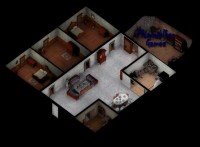| |
Site Navigation
Main
News
Forums
Games
Games Database
Top 100
Release List
Support Files
Features
Reviews
Previews
Interviews
Editorials
Diaries
Misc
Download
Gallery
Music
Screenshots
Videos
Miscellaneous
Staff Members
Privacy Statement
|
|
RPGVault brings you an interview with Lead Designer J.E. Sawyer from the Icewind Dale 2 team. Here's something about what the 3e rules mean for the game:
Jonric: How to these 3E changes work, and do you feel they'll have significant impact in terms of the overall gameplay?
J.E. Sawyer: Though some may consider those changes to be trivial or, at worst, detrimental, to overall gameplay, they actually allow us to make things clearer for the player. Because Danien Chee had to rip out most of the THAC0 code to implement base attack bonus, he was able to make individual bonus types apparent on the character record screen. When a player views their total attack bonus, they will see their base attack bonus, weapon modifiers, ability score modifiers, proficiency modifiers, and miscellaneous modifiers, for both hands. This should help clear up "mystery bonuses" in the engine that often are unclear to the player. In addition to that minor side effect, base attack bonus also allows characters of all classes to gain additional attacks as their base attack bonus increases. Thieves and mages will never be the melee powerhouses that fighters are, but this change makes them a little more useful in weapon combat at higher levels.
A character's armor class will be broken down into armor bonus (suits of armor and magical bracers), shield bonus, deflection bonus (rings, cloaks, etc.), dexterity bonus, and miscellaneous bonuses. These classifications always stack with each other, but do not stack with like bonuses except for misc. bonuses, which is the "catch-all". A player should never see a "You may not wear this piece of equipment due to a conflict with blah, blah" message in Icewind Dale II. The engine automatically excludes like bonuses, allowing only the highest of any given type to count towards the character's AC. If a character put on a Ring of Protection +1, a Cloak of Protection +1, and a Hat of Protection +3, the character would only gain deflection AC benefits from the Hat of Protection +3. This segregation of armor types in the engine also makes touch-based spells much more viable. Whenever a character uses a touch-based spell like Shocking Grasp or Harm, the character ignores the target's armor bonus.
The 3E ability score scale is strictly linear. Every two points above 10 results in +1 to most modifiers based on that stat. A 12 strength, for instance, grants +1 to hit and +1 to damage with melee weapons. A 14 dexterity grants a +2 bonus to armor class and +2 to hit with missile weapons. The 8-14 point "dead zone" from 2nd Edition is gone on this scale. Overall, the scale is much less arbitrary and much more uniform. Players don't have to look at a chart to know that a +2 increase at 10 yields the same net bonus as a +2 increase at 22. |
|
|





 Icewind Dale 2 Interview at RPGVault
Icewind Dale 2 Interview at RPGVault